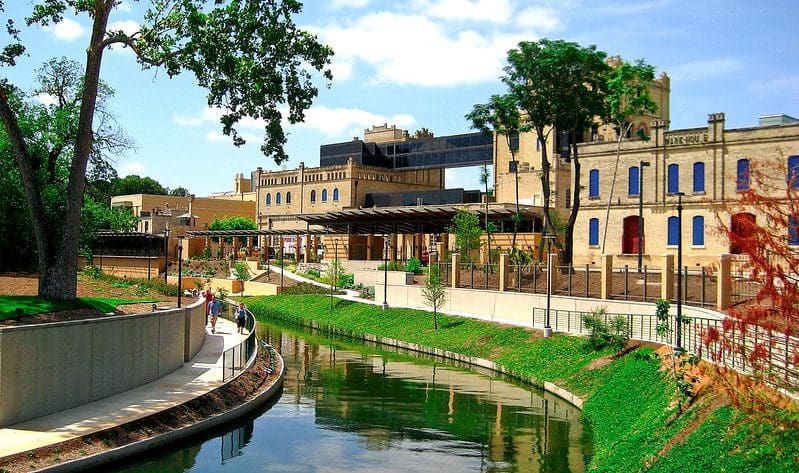
The San Antonio Riverwalk is an iconic landmark that has been captivating visitors for decades. The riverwalk is a network of walkways along the banks of the San Antonio River that is lined with shops, restaurants, and bars. It is a popular destination for tourists and locals alike, and it has become an integral part of the city’s identity.
However, the history of the San Antonio Riverwalk goes back much further than its current popularity would suggest. The river has been a vital part of the city’s history for centuries, and the riverwalk itself has undergone many changes and transformations over the years. From its humble beginnings as a concrete channel to its current status as a world-renowned attraction, the San Antonio Riverwalk is a testament to the city’s rich history and heritage.
History of the San Antonio Riverwalk
The San Antonio Riverwalk, also known as Paseo del Rio, is a popular tourist attraction in the city of San Antonio, Texas. The riverwalk is a 15-mile urban park that winds through the heart of the city and is lined with shops, restaurants, bars, and hotels. The riverwalk was built to help revitalize the downtown area and has become a symbol of the city’s rich cultural heritage.
Early History
The San Antonio River has been an important source of water for the region for thousands of years. The river was home to the Payaya tribes, who were the first inhabitants of the area. In the 18th century, the Spanish colonial missions were built along the river to convert the indigenous people to Christianity. The missions, including the Alamo, are now part of the San Antonio Missions National Historical Park, a UNESCO World Heritage Site.
Design and Construction
In the early 20th century, Robert H. H. Hugman, an architect and urban planner, developed a plan for the riverwalk. Hugman’s plan included walkways along the river, bridges, stairways, and lighting. He envisioned the riverwalk as a way to connect the city’s Spanish colonial missions and to create a commercial development that would attract tourists.
Construction of the riverwalk began in 1939 and was completed in 1941. The Works Progress Administration (WPA), a New Deal agency, provided funding for the project. The riverwalk was built using local materials, including limestone and river rock.
Great Depression and Flood Control
The construction of the riverwalk was part of a larger effort to revitalize the city during the Great Depression. The riverwalk was designed to provide jobs and stimulate the local economy. The riverwalk also served a practical purpose: it was part of a flood control project that included the Olmos Dam and a bypass channel.
The riverwalk has been expanded several times since its construction. In the 1960s, the Paseo del Alamo was built, connecting the riverwalk to the Alamo. In the 1970s, the riverwalk was extended to the Museum Reach, which includes the San Antonio Museum of Art and the historic Pearl Brewery. In 2013, the riverwalk was extended again to the Mission Reach, which includes the city’s four other Spanish colonial missions.
Today, the San Antonio Riverwalk is a vibrant urban park that attracts millions of visitors each year. The riverwalk is home to numerous cultural events, including the annual Fiesta San Antonio and the Fiesta River Parade. The riverwalk is also home to many restaurants, shops, and hotels, including the iconic Casa Rio restaurant and the Rivercenter Mall.
Heritage of the San Antonio Riverwalk
The San Antonio River Walk is a cultural and historical landmark that has been a popular attraction for tourists and locals alike for nearly a century. The River Walk is a network of walkways along the San Antonio River that is lined with shops, restaurants, and attractions. The River Walk is a testament to the rich heritage of San Antonio and the Texan culture, and it has become an essential part of the city’s identity.
Culture and Entertainment
The River Walk is a hub of cultural and entertainment activities in San Antonio. The River Walk is home to numerous festivals, live music, and theater performances throughout the year. The River Walk is also a popular destination for art lovers, with numerous galleries and public art installations lining the walkways. The Museum Reach section of the River Walk is a must-visit for those interested in the history and culture of San Antonio.
Attractions and Shops
The River Walk is home to several attractions that showcase the history and heritage of San Antonio. The Hemisfair Park, located at the southern end of the River Walk, is a popular destination for families with its playgrounds, fountains, and open spaces. The Pearl, located in the northern part of the River Walk, is a mixed-use development that features shops, restaurants, and a farmers market. The River Walk is also home to several museums and historic sites, including the Alamo and the San Antonio Missions National Historical Park.
The River Walk is also a shopper’s paradise, with numerous shops and boutiques selling everything from souvenirs to high-end fashion. The River Walk is a great place to find unique gifts and mementos of your visit to San Antonio.
Restaurants and Hotels
The River Walk is a foodie’s paradise, with numerous restaurants and cafes serving up delicious Texan and international cuisine. The River Walk is a great place to sample Tex-Mex cuisine, with several restaurants serving up traditional dishes like enchiladas, fajitas, and tacos. The River Walk is also home to several fine-dining establishments, serving up everything from steak to sushi.
The River Walk is also home to several hotels, ranging from budget-friendly options to luxury accommodations. Staying at a hotel on the River Walk is a great way to experience the city’s culture and heritage while enjoying the convenience of being close to all the attractions and shops.
In recent years, the River Walk has undergone significant improvements, including the expansion of the Museum Reach section and the addition of new parks and attractions. The River Walk remains an essential part of San Antonio’s heritage and culture, and it is sure to continue to be a popular destination for years to come.
Current Status of the San Antonio Riverwalk
Recent Developments
In recent years, the Riverwalk has undergone significant improvements, including the Museum Reach extension, which added 1.3 miles of walkways and public art to the Riverwalk. This extension connects the Riverwalk to the San Antonio Museum of Art and the Pearl, a mixed-use development with shops, restaurants, and apartments.
The San Antonio Riverwalk has become a cultural icon of the city, attracting millions of visitors each year. The Riverwalk is home to many historical landmarks, including the Alamo, the Spanish colonial missions, and La Villita, a historic arts village. The Riverwalk also hosts many events throughout the year, including the Fiesta River Parade and the lighting of the Riverwalk during the holiday season.
In conclusion, the San Antonio Riverwalk is a vital part of the city’s culture and history. The Riverwalk has undergone significant improvements in recent years and has implemented flood control measures to prevent damage from flooding. The Riverwalk remains a popular tourist attraction and a source of pride for residents of San Antonio.







